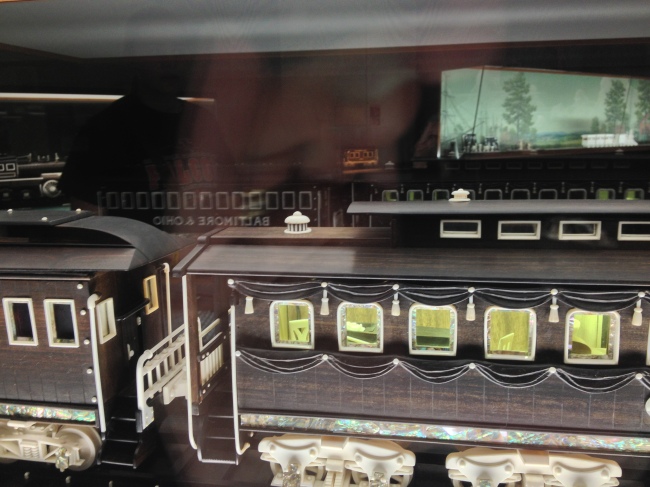“It’s impossible,” they said, on June 24, 1913, when Mooney Warther made his proclamation about the pliers tree he planned to whittle.
“I just got a strange vision…of a very strange piece of carving,” he said. “…Now the first cut will be made on this narrow end,” he continued, holding a small block of wood. “… on a 45 degree angle quarter way deep and half way down… All cuts from there on will descend from that one cut…That last cut will number 31,000 cuts… this block of wood will open up like a tree. All the wood will remain right where it is, with no lines and no shavings…”
Below is the pliers tree, behind glass. The family considers it priceless because it can’t be duplicated.
Mooney in fact predicted when he would finish the piece. And he was right. His pliers tree still amazes mathematical scholars and several generations of museum visitors, particularly since this world-famous carver had only a second grade education. “I seen it in the wood,” said Mooney. “I seen it in the wood.”
What he saw was that ten cuts would open up into a single pair of pliers; 32 cuts made three pairs, and 82 cuts made seven pairs. And finally, 31,000 cuts turned the single block of wood into a tree of pliers.
After Mooney finished his pliers tree, he decided to quit whittling, which he considered to be aimless, and to start carving, which would allow him to leave something behind for future generations.
So he set out to carve the history of the steam engine, going back as far as they could prove the use of steam as an energy source, 250 BC. His motto was, “Build everything to last forever.” And so far, his carvings have lasted for four generations.
Below is a scaled model of the train that carried Abraham Lincoln’s coffin. That’s Lincoln, lying in repose in the second window from the left in the bigger train car.
I started going to the Warther Museum when I was a little girl and I never grow tired of it. I learn and see something new every time I go, whether it’s about Mooney’s history or philosophy, about the ebony and ivory that he used for (legal and humanely acquired) materials, or whether it’s about the fully mechanized trains he carved, perfectly to scale.
In fact, when the New York Central railroad execs saw his work, they found them so perfect in every detail that they asked him to exhibit his first 15 train carvings in a traveling promotion. More than ¾ million people viewed the show before it was displayed for two years in Grand Central Station. Carvers from Oberammergau, Germany, considered to be the best in the world, saw Mooney’s work and named him “The World’s Master Carver.”
Mooney was offered $50,000 and $5,000 yearly in the 1920s to keep his display in Grand Central, but he turned it down. “My roof don’t leak and I ain’t hungry…” he said. He returned to his family and home in Ohio, where, in order to continue to make a modest living, he went back to making and selling knives, like these cherished works of art given to me by my parents. Though my dad has passed, I want him to know, “I still don’t put them into the dishwasher, because of the wood. It slows me down, just a little, to wash them by hand. But that’s a good thing.”
Still family owned, the museum gift shop sells 17 styles of knives with lifetime guarantees. Visit the Warther Museum the next time you’re in Ohio, in Amish country.
And how about you? Would you turn down today’s equivalent of $50,000 in the 20s?


 Follow
Follow


Leave a Reply